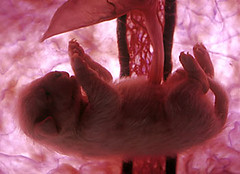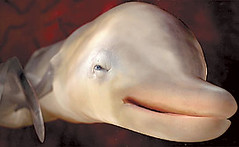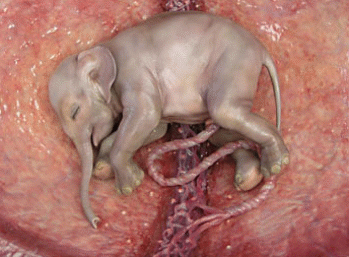Using an array of technologies, a series of images reveal the secret of animal development in the wormb. Using a combination of three-dimensional ultrasound scans, computer graphics and tiny cameras, the research team followed the entire developmental process from conception to birth for a variety of animals, including an elephant (pictured). The team found some interesting behaviors along the way; a dolphin swimming in the womb, and an unborn dog (right) panting. 
"The images in the film are a testament to the ingenuity and patience of the production team led by Yavar Abbas and Dr David Barlow, who worked with some of the world's leading vets to obtain these pictures."
The fetal images were created for the program Animals In The Womb, a two-hour program that will be broadcast on the National Geographic Channel in the USA and the UK next month and on Channel 4 in the UK next year.
The program shows how, at nearly one year of age, the trunk is longer than the legs, and by 14 months, the characteristically large and flat elephant ears are visible. these ears will eventually grow to almost two feet across and are used to help regulate the body temperature. At birth, an elephant will weigh nearly 260lb and be able to take his first steps in minutes.
 Interestingly, the researchers found that at 24 days, the dolphin embryo (pictured, left) develops tiny leg-like buds, which then disappear over the next two weeks. They also show the moment when a baby dolphin learns to swim while in the womb after eight weeks'gestation. During next few weeks, the dolphin develops flippers, a tail and a blowhole before being born after a year in the womb, and must be able to quickly swim to the surface to take its first breath of air.
Interestingly, the researchers found that at 24 days, the dolphin embryo (pictured, left) develops tiny leg-like buds, which then disappear over the next two weeks. They also show the moment when a baby dolphin learns to swim while in the womb after eight weeks'gestation. During next few weeks, the dolphin develops flippers, a tail and a blowhole before being born after a year in the womb, and must be able to quickly swim to the surface to take its first breath of air.
The footage also shows how many animal embryos are like human ones.
"The incredible thing about the early images is how we all look very similar - it is obviously we humans share a common mammalian ancestry very early in life," said Mr Dear.
Cited story.
.



I really like these pictures, but the seemingly huge seperation between the fetuses and the maternal tissues bothers me more each time I see them.
There appears to be short trailer video at Pioneer Productions as well.
Nix that last comment; it is for a previous human development video.
bye bye
i
i m for mumbai
age in m22